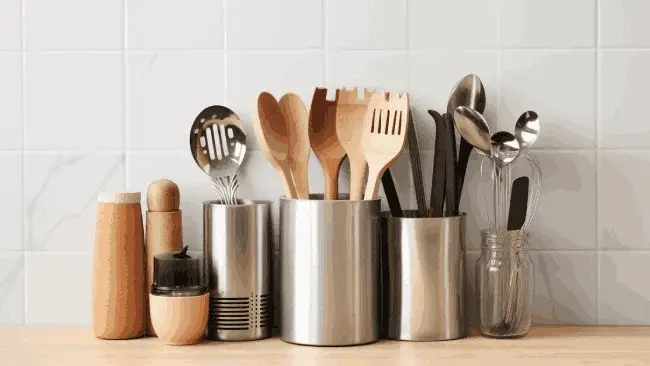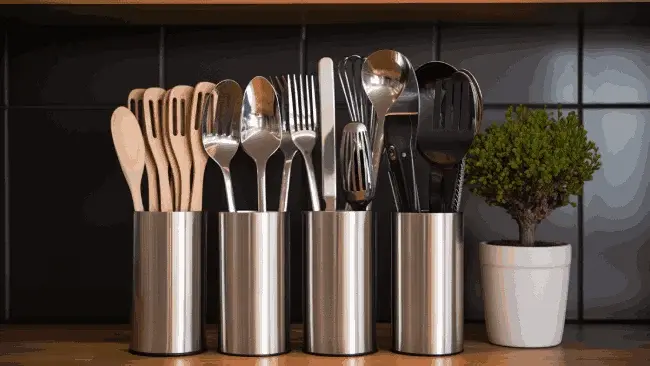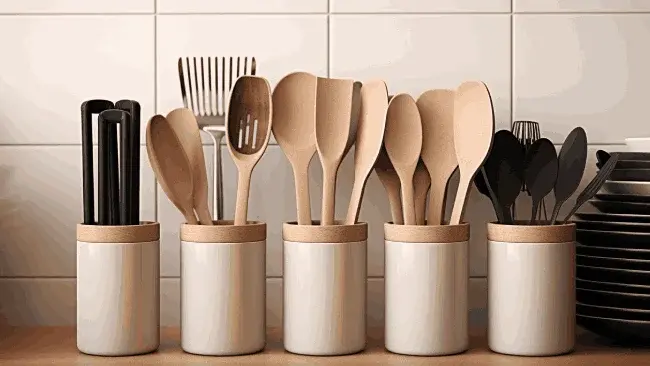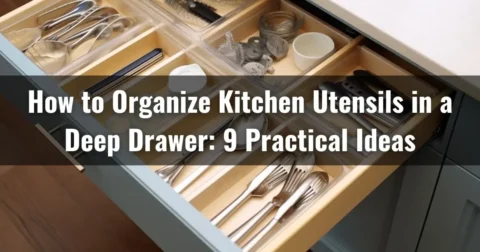Proper in-use utensil storage is fundamental to food safety and hygiene within the culinary industry. The kitchen utensils tend to become vectors for contamination and foodborne illness during food preparation and service. Without an approved method for storing in-use utensils, your health could be put at risk.
You can wipe the utensils clean with sanitizer and store them properly. Another option is to utilize a dipper well with continuous water flow, which helps keep the utensils clean and ready for use.
Also, you can keep the utensils in hot water at a temperature of 140°F or higher, ensuring they remain safe and sanitary, which is crucial for proper cleaning and preventing bacterial growth. This method is effective in keeping food contact surfaces clean. Some establishments incorporate utensils into the food product during holding, allowing for convenience and efficiency.
This article will discuss four proven methods for storing in-use utensils in your kitchen area.
4 Approved Methods for Storing in Use Utensils
In terms of storing in-use utensils, there are several approved methods that you can follow.

We recommend the following methods to keep used utensils clean and free of cross-contamination.
- Method 01. Wiping clean with sanitizer and proper storage
- Method 02. Utilizing a dipper well with continuous water flow
- Method 03. Keeping utensils in hot water (140°f or higher)
- Method 04. Incorporating utensils into food products during holding
Let’s take a closer look at each of these approved methods for storing in use utensils.
Method 01. Wiping Clean with Sanitizer and Proper Storage
We recommend Cleaning your utensils with sanitizer and storing them properly to maintain food safety. Start using a food-safe sanitizer to thoroughly clean your utensils, removing any visible food debris or residue. This step will prevent the growth of harmful bacteria and maintain the overall cleanliness of your utensils.
Once cleaned, store the utensils in a designated temporary clean and dry area. This storage space should be well-ventilated and free from potential sources of contamination.
Regularly inspect and clean the temporary storage area to prevent the accumulation of dirt or contaminants that could compromise food safety.
Method 02. Utilizing a Dipper Well with Continuous Water Flow
Keep your used utensils submerged in the dipper well with continuous water flow, ensuring maximum cleanliness and hygiene. Set up a dipper well with a continuous, clean, potable water flow. Ensure the water covers the utensils completely by fully submerging them in the dipper well.
This constant water flow is essential as it flushes out any food particles, preventing bacteria from growing on the utensils. Most kitchen experts suggest regularly checking the dipper well to ensure it maintains the water flow.
Method 03. Keeping Utensils in Hot Water (140°F or Higher)
You can ensure your used utensils’ safety by keeping them fully submerged in hot water at 140°F or higher, effectively preventing bacterial growth and ensuring proper cleaning and sanitizing. Maintaining a water temperature of at least 140°F is crucial, so regularly verify and monitor it using a reliable thermometer.
It’s essential to fully submerge the used kitchen utensils. To continuously sanitize your utensils, remember to keep them in the hot water when not in use, emphasizing proper cleaning and sanitizing practices. It’s also important to replace the hot water as needed to maintain the appropriate temperature and prevent bacterial growth.
Method 04. Incorporating Utensils Into Food Product During Holding
To maintain temperature control and easy accessibility, submerge the specific utensils in the food product, ensuring their handles extend outside the container. Incorporating the utensils into the food item during holding provides a safe and efficient way to store and access them during food preparation and service.
As reported by our research, placing those utensils within the food product minimizes the risk of contamination, as they’re kept in a controlled environment, which is critical for proper utensil storage. This ensures that the utensils are readily available and maintained at the appropriate temperature for either hot or cold items.
Whether you’re holding cold food below 41°F/4°C or hot food above 135°F/60°C, using this method will allow you to access utensils easily.
How Do You Store Utensils in the Kitchen?
We’ve shown you how to store utensils when they are in use. Now let’s look at how you can store them when they are not in use.

- Drawer organizers
- Wall-mounted racks
- Countertop utensil caddies
- Hanging rails or bars
No 01. Drawer Organizers
Start by selecting a suitable-sized drawer for your utensils. Next, we recommend purchasing drawer organizers with compartments designed to hold different utensils, such as forks, knives, spoons, and other kitchen tools.
Once you have your organizers, place them within the drawer, ensuring each utensil has its designated compartment. This method keeps your utensils organized and saves you time and effort when searching for the right tool.
No 02. Wall-Mounted Racks
Hang your utensils on the wall-mounted rack and ensure they’re easily accessible for your cooking needs. Wall-mounted racks are a convenient and space-saving solution for storing your utensils.
To install one, choose a location on your kitchen wall that’s within reach while you’re cooking. Ensure the rack is securely attached using wall anchors and screws to prevent accidents.
Once the rack is in place, hang your utensils using hooks, pegs, or slots designed for this purpose. With this method, all of your kitchen utensils are within arm’s reach and add a decorative element to your kitchen decor.
No 03. Countertop Utensil Caddies
We strongly suggest keeping your most frequently used utensils within easy reach by placing them in a countertop utensil caddy. Countertop utensil caddies are a convenient and stylish option for storing your utensils.
Whether you purchase a ready-made caddy or create your own using a decorative container or organizer, you can always have access to your kitchen utensils. Simply place the caddy on your kitchen countertop near your cooking area for easy access.
To keep your utensils organized, sort and arrange them in the caddy, separating them by type or use. We hope this saves you time searching for the right utensil and adds a touch of elegance to your kitchen decor.
No 04. Hanging Rails or Bars
You can easily optimize your kitchen storage by installing hanging rails or bars, allowing you to showcase your utensils while saving space.
To set up this storage method, we suggest choosing a suitable location such as beneath your kitchen cabinets or on a wall. Ensure the rail or bar is securely mounted and can support the weight of your utensils.
Next, attach S-hooks, magnetic strips, or other appropriate holders to hang your utensils. This method maximizes storage space and provides easy access and visual organization. You can hang your frequently used utensils, such as spatulas, ladles, and tongs, ensuring they’re always within reach.
FAQ’s: Approved Method for Storing in Use Utensils
Here are some frequently asked questions to help you out based on utensil storage ideas.
1. Is it safe to store utensils near the sink area?
While having kitchen utensils within your sink area may be convenient, you should be cautious about water exposure. Moisture buildup can lead to rust or mold on metal utensils, compromising their quality and safety.
To ensure your utensils’ safety, it is recommended to ensure the storage area is well-ventilated. This will help prevent moisture from accumulating on the surface and causing damage. Also, it’s a good practice to wipe down your utensils after each use and ensure they’re completely dry before storing them near the sink.
2. Can I store utensils in the dishwasher between uses for easy access and cleaning?
Storing utensils in the dishwasher between uses can lead to rust or deterioration over time, so it’s best to find alternative storage methods. The moisture accumulating in the dishwasher can create a damp environment, which isn’t ideal for utensils.
Over time, this moisture can cause rust on the utensils, leading to deterioration and potential health risks. To ensure the longevity of your utensils, it’s recommended to use dedicated storage methods such as utensil holders or drawers.
3. Are there eco-friendly utensil storage options available?
Bamboo utensil holders are popular, as bamboo is a renewable resource that grows quickly and doesn’t require pesticides or fertilizers.

You can also find utensil storage solutions made from reclaimed wood, which adds a rustic touch to your kitchen and reduces waste by repurposing materials.
Another option is storage containers made from recycled plastics, which help to minimize the use of new plastic and reduce the amount of plastic waste in landfills.
These eco-friendly utensil storage options contribute to a greener lifestyle and provide functional and stylish storage solutions for your kitchen.
Conclusion
Storing used utensils is a matter of utmost importance in the kitchen. By following the approved method for storing in use utensils outlined in this article, cross-contamination can be prevented, and cleanliness can be promoted.
It doesn’t matter what method is used to store utensils so that food stays safe. Whether it is wiping utensils clean with sanitizer, running water in dipper wells, submerging them in hot water, or adding them to food during holding.
Remember that a well-organized kitchen isn’t only visually appealing but also essential for maintaining a safe and hygienic cooking environment.




